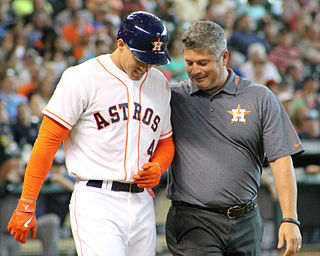
A podiatrist is a medical professional devoted to the treatment of disorders of the foot, ankle, and related structures of the leg. The term originated in North America but has now become the accepted term in the English-speaking world for all practitioners of podiatric medicine. The word chiropodist was previously used in the United States, but it is now regarded as antiquated.
A dietitian, medical dietitian, or dietician is an expert in identifying and treating disease-related malnutrition and in conducting medical nutrition therapy, for example designing an enteral tube feeding regimen or mitigating the effects of cancer cachexia. Many dietitians work in hospitals and usually see specific patients where a nutritional assessment and intervention has been requested by a doctor or nurse, for example if a patient has lost their ability to swallow or requires artificial nutrition due to intestinal failure. Dietitians are regulated healthcare professionals licensed to assess, diagnose, and treat such problems. In the United Kingdom, dietitian is a 'protected title', meaning identifying yourself as a dietitian without appropriate education and registration is prohibited by law.
A Physician Assistant or Physician Associate (PA) is a type of healthcare professional. While these job titles are used internationally, there is significant variation in training and scope of practice from country to country, and sometimes between smaller jurisdictions such as states or provinces. Depending on location, PAs practice semi-autonomously under the supervision of a physician, or autonomously perform a subset of medical services classically provided by physicians.

Podiatry, or podiatric medicine and surgery, is a branch of medicine devoted to the study, diagnosis, and treatment of disorders of the foot, ankle and lower limb. The healthcare professional is known as a podiatrist. The US podiatric medical school curriculum includes lower extremity anatomy, general human anatomy, physiology, general medicine, physical assessment, biochemistry, neurobiology, pathophysiology, genetics and embryology, microbiology, histology, pharmacology, women's health, physical rehabilitation, sports medicine, research, ethics and jurisprudence, biomechanics, general principles of orthopedic surgery, plastic surgery, and foot and ankle surgery.
Athletic training is an allied health care profession recognized by the American Medical Association (AMA) that "encompasses the prevention, examination, diagnosis, treatment, and rehabilitation of emergent, acute, or chronic injuries and medical conditions." There are five areas of athletic training listed in the seventh edition (2015) of the Athletic Training Practice Analysis: injury and illness prevention and wellness promotion; examination, assessment, diagnosis; immediate and emergency care; therapeutic intervention; and healthcare administration and professional responsibility.

An athletic trainer is a certified and licensed health care provider who practices in the field of sports medicine. Athletic training has been recognized by the American Medical Association (AMA) as an allied health care profession since 1990.
A medical assistant, also known as a "clinical assistant" or healthcare assistant in the US is an allied health professional who supports the work of physicians, nurse practitioners, physician assistants and other health professionals, usually in a clinic setting. Medical assistants can become certified through an accredited program. Medical assistants perform routine tasks and procedures in a medical clinic.

Medical education is education related to the practice of being a medical practitioner, including the initial training to become a physician and additional training thereafter.
Allied health professions (AHPs) are a group of health care professions that provide a range of diagnostic, technical, therapeutic, and support services in connection with health care, and which are distinct from the fields of dentistry, optometry, medicine, nursing and pharmacy.

Western University of Health Sciences (WesternU) is a private medical university in Pomona, California. With an enrollment of 3,724 students (2022–23), WesternU offers more than twenty academic programs in multiple colleges. It also operates an additional campus in Lebanon, Oregon.

The University of Nebraska Medical Center (UNMC) is a public academic health science center in Omaha, Nebraska. Founded in 1869 and chartered as a private medical college in 1881, UNMC became part of the University of Nebraska System in 1902. Rapidly expanding in the early 20th century, the university founded a hospital, dental college, pharmacy college, college of nursing, and college of medicine. It later added colleges of public health and allied health professions. One of Omaha's top employers, UNMC had an annual budget of $841.6 million for 2020 to 2021 and an economic impact of $4.8 billion.
Drexel University College of Medicine is the medical school of Drexel University, a private research university in Philadelphia, Pennsylvania. The medical school represents the consolidation of two medical schools: Hahnemann Medical College, originally founded as the nation's first college of homeopathy, and the Woman's Medical College of Pennsylvania, the first U.S. medical school for women, which became the Medical College of Pennsylvania when it admitted men in 1970; these institutions merged in 1993, became affiliated with Drexel University College of Medicine in 1998, and were fully absorbed into the university in 2002. With one of the nation's largest enrollments for a private medical school, Drexel University College of Medicine is the second most applied-to medical school in the United States. It is ranked no. 83 in research by U.S. News & World Report.
Most physicians in the United States hold either the Doctor of Medicine degree (MD) or the Doctor of Osteopathic Medicine degree (DO). Institutions awarding the MD are accredited by the Liaison Committee on Medical Education (LCME). Institutions awarding the DO are accredited by the Commission on Osteopathic College Accreditation (COCA). The World Directory of Medical Schools lists both LCME accredited MD programs and COCA accredited DO programs as US medical schools. Foreign-trained osteopaths do not hold DO degrees and are not recognized as physicians in the United States or in other jurisdictions.
The Accrediting Bureau of Health Education Schools (ABHES) is a recognized higher education accreditation organization in the United States specializing in the institutional accreditation of private, postsecondary institutions that offer allied health education programs, and the programmatic accreditation of programs leading to associate degrees or certificates in the medical assistant, medical laboratory technician and surgical technology fields. The ABHES is the only healthcare education accrediting agency that is recognized by the U.S. Department of Education. In addition to recognition by the U.S. Department of Education, the ABHES is also recognized by the American Association of Medical Assistants (AAMA), the American Medical Technologists (AMT) and the Liaison Council for Certification of Surgical Technologists (LLC-ST).

Mayo Clinic School of Health Sciences (MCSHS), formerly known as Mayo School of Health Sciences (MSHS), is an accredited, private, nonprofit school of higher education specializing in allied health education. MCSHS operates within the Mayo Clinic College of Medicine and Science, which is the educational division of Mayo Clinic. As such, MCSHS is fully integrated with Mayo Clinic hospitals and clinics.
Certified anesthesiologist assistants (CAAs) are master’s degree level non-physician anesthesia care providers. CAAs are members of the anesthesia care team as described by the American Society of Anesthesiologists (ASA). This designation must be disambiguated from the Certified Clinical Anesthesia Assistant (CCAA) designation conferred by the Canadian Society of Respiratory Therapists. All CAAs possess a baccalaureate degree, and complete an intensive didactic and clinical program at a postgraduate level. CAAs are trained in the delivery and maintenance of most types of anesthesia care as well as advanced patient monitoring techniques. The goal of CAA education is to guide the transformation of student applicants into competent clinicians.

Nevada Career Institute is a for-profit technical college in Las Vegas, Nevada. Nevada Career Institute is owned and operated by the Fuerst family of Success Education Colleges.
The Bureau of Health Workforce is a part of the Health Resources and Services Administration (HRSA), of the United States Department of Health and Human Services. HRSA programs train health care professionals and place them where they are needed most. Grants support scholarship and loan repayment programs at colleges and universities to meet critical workforce shortages and promote diversity within the health professions.
Ultimate Medical Academy (UMA) is a nonprofit career education school that grants associate degrees and training in the allied health field. The institution also provides continuing medical education (CME) to more than 30,000 physicians, nurses and other medical professionals annually.
Gurnick Academy is a private for-profit higher-education institution in California providing nursing, imaging and allied health programs. The school’s corporate office is located in San Jose, California, and it operates six campuses, in San Jose, Concord, Modesto, Fresno, Sacramento and Los Angeles, as well as offering distance education online. The academy is operated and owned by the Gurnick Academy of Medical Arts, with Konstantin Gourji as the chief executive officer.







